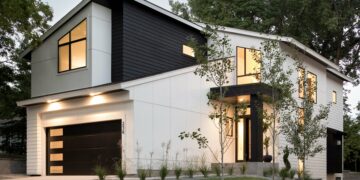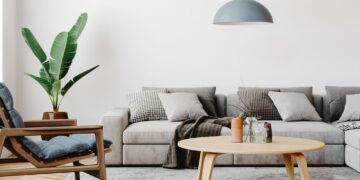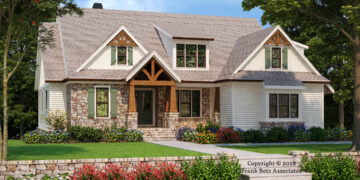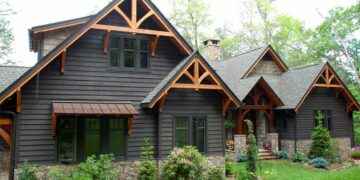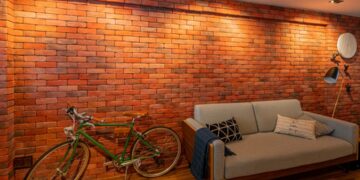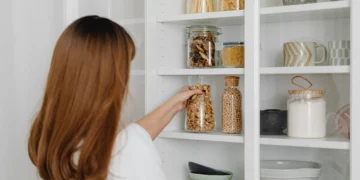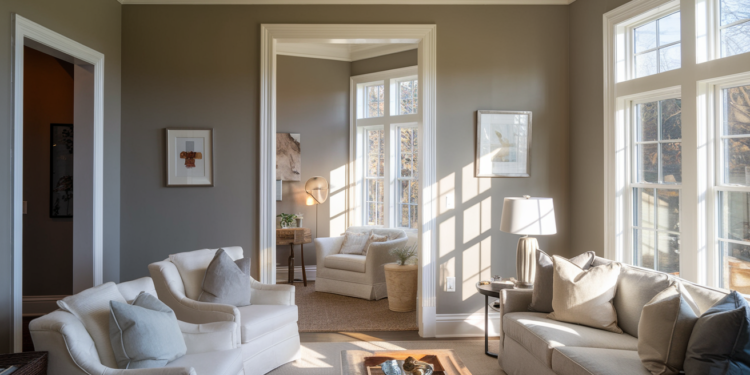Gray paint brings a mix of style and comfort to any room.
As more people choose gray for their walls, picking the right shade becomes key for creating spaces that feel just right.
The best gray isn’t just about the color – it’s about how it works with your room’s natural light, fits with your furniture, and suits what you do in that space.
In this guide, we’ll look at the top warm gray paint colors that add comfort without feeling cold.
We’ll show you how each shade looks in real rooms, what makes it special, and where it works best, helping you make a choice you’ll love.
Why Choose Warm Gray Paint Colors?

Warmth and Versatility
Warm gray paint makes spaces comfortable while staying simple.
These shades mix gray with hints of brown or beige, adding a soft, friendly touch to any room.
These colors fit well with many styles. They look classic in rooms with traditional details and work just as well with modern designs.
In living rooms, kitchens, and bedrooms, warm grays create a calm setting that pairs nicely with white or wood features.
As daylight changes, these grays stay beautiful.
They look cozy in morning light and soft in the evening, making them a reliable choice for any space.
The Importance of Lighting
Light changes how warm gray paint appears on your walls.
Natural light shifts its look throughout the day – morning sun creates a soft feel, while north-facing rooms show cooler tones and south-facing spaces highlight warmth.
Your choice of light bulbs also affects the color.
Warm LEDs (2700-3000K) make grays feel cozy, while cool bulbs (4000K+) create a fresh look.
Quick Testing Tips
- Paint 2-foot squares on different walls
- Check the color at different times of day
- Test under your room’s lighting
- View it next to your furniture
- Give it 2-3 days to see changes
Top Warm Gray Paint Colors
1. Sherwin-Williams Drift of Mist

Drift of Mist brings subtle brown and taupe notes to your walls, creating a welcoming atmosphere that’s perfect for family spaces.
In rooms with good sunlight, it changes throughout the day while maintaining its cozy feel.
It’s an ideal choice for bedrooms and living areas where comfort matters most.
2. Benjamin Moore Gray Owl

Gray Owl balances warm and cool undertones, making it suitable for various settings.
In rooms with morning or afternoon sunlight, it shifts beautifully while keeping its balanced character.
The color stays true without becoming too dark or too light as lighting changes.
3. Benjamin Moore Edgecomb Gray

Edgecomb Gray blends gray and beige perfectly, adapting to different lighting conditions throughout your home.
It’s especially good for open floor plans where you want color continuity.
The shade maintains its warmth while changing subtly from space to space, creating a cohesive look.
4. Benjamin Moore Revere Pewter

A reliable neutral that combines soft brown with gray undertones, making it practical for busy areas.
Revere Pewter works well in main living spaces and kitchens where you need a color that stays attractive under various conditions.
It provides a steady backdrop for daily activities.
5. Sherwin-Williams Agreeable Gray

Agreeable Gray includes subtle green undertones that add depth to its neutral base.
It performs well in spaces with mixed lighting conditions, maintaining its warmth under both natural and artificial light.
The color creates a balanced background that works with various decor styles.
6. Benjamin Moore Pale Oak

Pale Oak is a light taupe combines warm gray and beige tones to create a subtle but effective neutral.
It’s particularly good for hallways and kitchens, especially in spaces with dark floors.
The color brightens areas while maintaining a soft, warm presence.
7. Sherwin-Williams Eider White

Eider White is a nearly-white shade with warm gray undertones that brings brightness while keeping spaces inviting.
It’s perfect for making small rooms feel larger without becoming stark.
The color maintains its warmth even in spaces with limited natural light.
How to Test Warm Grays in Your Space

Sampling Paint Colors
Paint colors can look very different on your walls than they do on sample cards.
A quick test helps you avoid costly mistakes.
Smart Testing Methods use peel-and-stick samples or paint 2-foot squares on different walls.
Put samples in several spots to see how light affects the color.
Light Changes Matter
- Morning: See the true color in early sunlight
- Midday: Check how bright light changes the shade
- Evening: Watch how the color shifts at sunset
- Night: Test with your regular lighting
Quick Tips
- Keep samples up for 3 days
- Check from different spots in the room
- Test near your furniture and trim
- Take photos at different times
- Colors usually look darker on full walls than on samples.
- Choose a slightly lighter shade if you’re unsure.
Pairing with Trim and Accent Colors
Good color matching between walls, trim, and accent pieces creates a polished look.
Here’s what you should know:
White Trim Basics Pure white trim makes wall colors pop, while cream trim softens the look.
Always test wall colors with your trim samples.
Quick Check List to Test Paint Samples Against
- Floors and cabinets
- Main furniture
- Window coverings
- Light fixtures
Balance Matters. Soft wall colors work best with bold furniture.
If your furniture is neutral, your walls can handle more color.
Testing Spots to Put Samples
- By baseboards
- Near windows
- Around doors
Color Tips
Cool colors match bright white trim.
Warm colors work with cream trim.
Test all combinations in natural and artificial light to see their true appearance.
Common Mistakes to Avoid

When working with gray in your space, it’s easy to make a few simple errors.
Here are some mistakes you should try to stay away from to get the most out of this color.
Overwhelming Neutrality
While gray is a great base, your space needs some color to feel alive and welcoming.
Using only grays can make your room feel flat and boring.
Add small touches of color through items like pillows, art, or plants to bring life to a gray backdrop.
Mismatching Undertones
Not all grays are the same – they can have warm or cool undertones.
Mixing a warm gray (with yellow or brown hints) with cool colors like blue can clash.
Check your gray’s undertone in natural light and pair it with colors that match its warm or cool nature for a more put-together look.
Conclusion
Warm gray paint offers great options for home color.
By taking time to test samples in your space, you’ll find the perfect shade that works with your lighting and decor.
Remember that each room’s natural and artificial light will change how the color looks throughout the day.
Before buying paint for your whole project, always test a few options in your actual space.
Watch how the colors change from morning to night, and see how they look next to your furniture and trim.
This small step helps ensure you’ll be happy with your final choice.


